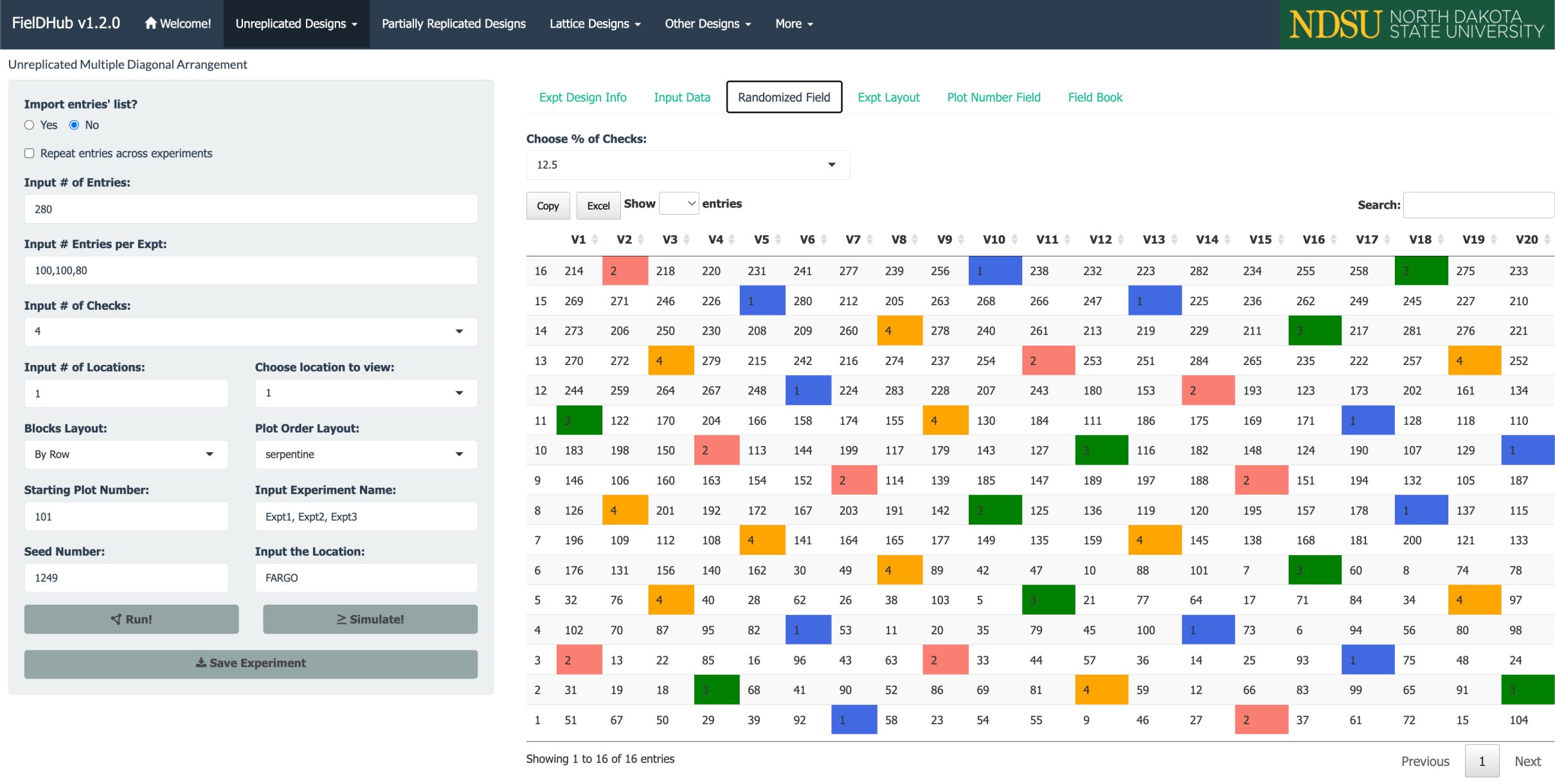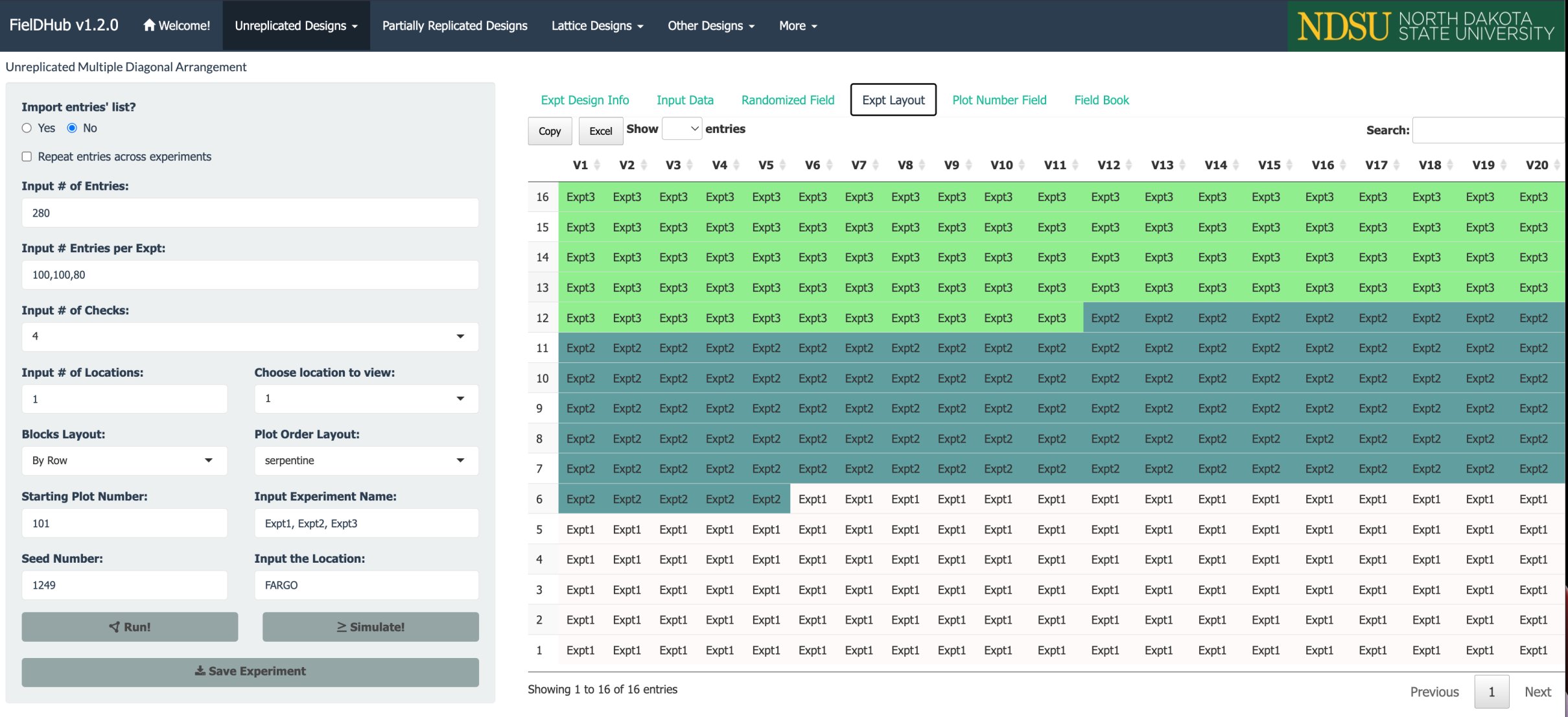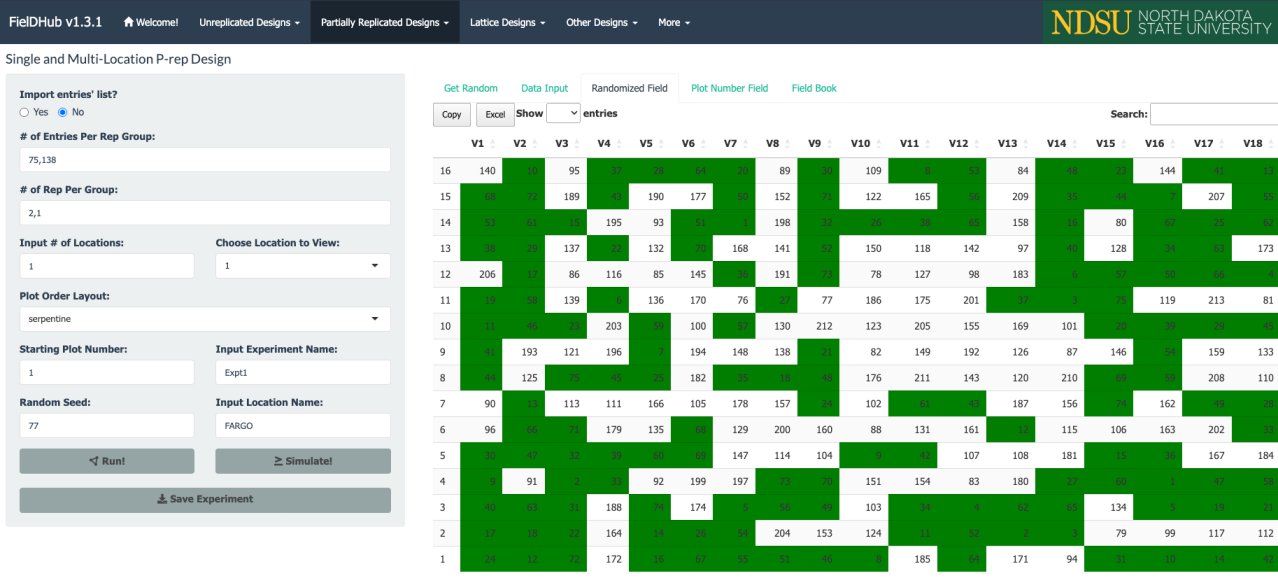install.packages("FielDHub")remotes::install_github("DidierMurilloF/FielDHub")A shiny design of experiments (DOE) app that aids in the creation of traditional, un-replicated, augmented and partially-replicated designs applied to agriculture, plant breeding, forestry, animal and biological sciences.
For more details and examples of all functions present in the FielDHub package. Please, go to https://didiermurillof.github.io/FielDHub/articles/diagonal_arrangement.html.

This is a basic example which shows you how to launch the app:
library(FielDHub)
run_app()A project needs to test 280 genotypes in a field containing 16 rows and 20 columns of plots. In this example, these 280 genotypes are divided among three different experiments. In addition, four checks are included in a systematic diagonal arrangement across experiments to fill 40 plots representing 12.5% of the total number of experimental plots. An option to include filler plots is also available for fields where the number of experimental plots does not equal the number of available field plots.

The figure above shows a map of an experiment randomized along with multiple experiments (three) and checks on diagonals. Distinctively colored check plots are replicated throughout the field in a systematic diagonal arrangement.

The figure above shows the layout for the three experiments in the field.
diagonal_arrangement()To illustrate using FielDHub to build experimental designs through R
code, the design produced in the R Shiny interface described above can
also be created using the function diagonal_arrangement()
in the R script below. Note, that to obtain identical results, users
must include the same random seed in the script as was used in the Shiny
app. In this case, the random seed is 1249.
diagonal <- diagonal_arrangement(
nrows = 16,
ncols = 20,
lines = 280,
checks = 4,
plotNumber = 101,
splitBy = "row",
seed = 1249,
kindExpt = "DBUDC",
blocks = c(100, 100, 80),
exptName = c("Expt1", "Expt2", "Expt3")
)Users can print the returned values from
diagonal_arrangement() as follow,
print(diagonal)
Un-replicated Diagonal Arrangement Design
Information on the design parameters:
List of 11
$ rows : num 16
$ columns : num 20
$ treatments : num [1:3] 100 100 80
$ checks : int 4
$ entry_checks : int [1:4] 1 2 3 4
$ rep_checks : num [1:4] 11 9 9 11
$ locations : num 1
$ planter : chr "serpentine"
$ percent_checks: chr "12.5%"
$ fillers : num 0
$ seed : num 1249
10 First observations of the data frame with the diagonal_arrangement field book:
ID EXPT LOCATION YEAR PLOT ROW COLUMN CHECKS ENTRY TREATMENT
1 1 Expt1 1 2023 101 1 1 0 51 Gen-51
2 2 Expt1 1 2023 102 1 2 0 67 Gen-67
3 3 Expt1 1 2023 103 1 3 0 50 Gen-50
4 4 Expt1 1 2023 104 1 4 0 29 Gen-29
5 5 Expt1 1 2023 105 1 5 0 39 Gen-39
6 6 Expt1 1 2023 106 1 6 0 92 Gen-92
7 7 Expt1 1 2023 107 1 7 1 1 Check-1
8 8 Expt1 1 2023 108 1 8 0 58 Gen-58
9 9 Expt1 1 2023 109 1 9 0 23 Gen-23
10 10 Expt1 1 2023 110 1 10 0 54 Gen-54First 12 rows of the field book,
head(diagonal$fieldBook, 12)
ID EXPT LOCATION YEAR PLOT ROW COLUMN CHECKS ENTRY TREATMENT
1 1 Expt1 1 2023 101 1 1 0 51 Gen-51
2 2 Expt1 1 2023 102 1 2 0 67 Gen-67
3 3 Expt1 1 2023 103 1 3 0 50 Gen-50
4 4 Expt1 1 2023 104 1 4 0 29 Gen-29
5 5 Expt1 1 2023 105 1 5 0 39 Gen-39
6 6 Expt1 1 2023 106 1 6 0 92 Gen-92
7 7 Expt1 1 2023 107 1 7 1 1 Check-1
8 8 Expt1 1 2023 108 1 8 0 58 Gen-58
9 9 Expt1 1 2023 109 1 9 0 23 Gen-23
10 10 Expt1 1 2023 110 1 10 0 54 Gen-54
11 11 Expt1 1 2023 111 1 11 0 55 Gen-55
12 12 Expt1 1 2023 112 1 12 0 9 Gen-9Users can plot the layout design from
diagonal_arrangement() using the function
plot() as follows,
plot(diagonal)
In the figure, salmon, green, and blue shade the blocks of unreplicated experiments, while distinctively colored check plots are replicated throughout the field in a systematic diagonal arrangement.
The main difference between using the FielDHub Shiny app and using
the standalone function diagonal_arrangement() is that the
standalone function will allocate filler only if it is necessary, while
in Shiny App, users can customize the number of fillers if it is needed.
In cases where users include fillers, either between or after
experiments, the Shiny app is preferable for filling and visualizing all
field plots.
To see more examples, go to https://didiermurillof.github.io/FielDHub/articles/diagonal_arrangement.html
Partially replicated designs are commonly employed in early generation field trials. This type of design is characterized by replication of a portion of the entries, with the remaining entries only appearing once in the experiment. As an example, considered a field trial with 288 plots containing 75 entries appearing two times each, and 138 entries only appearing once. This field trials is arranged in a field of 16 rows by 18 columns.

In the figure above, green plots contain replicated entries, and the other plots contain entries that only appear once.
partially_replicated()Instead of using the Shiny FielDHub app, users can use the standalone
FielDHub function partially_replicated(). The partially
replicated layout described above can be produced through scripting as
follows. As noted in the previous example, to obtain identical results
between the script and the Shiny app, users need to use the same random
seed, which, in this case, is 77.
pREP <- partially_replicated(
nrows = 16,
ncols = 18,
repGens = c(138,75),
repUnits = c(1,2),
planter = "serpentine",
plotNumber = 1,
exptName = "ExptA",
locationNames = "FARGO",
seed = 77
)Users can print returned values from
partially_replicated() as follows,
print(pREP)
Partially Replicated Design
Information on the design parameters:
List of 7
$ rows : num 16
$ columns : num 18
$ treatments_with_reps : int 75
$ treatments_with_no_reps: int 138
$ locations : num 1
$ planter : chr "serpentine"
$ seed : num 77
10 First observations of the data frame with the partially_replicated field book:
ID EXPT LOCATION YEAR PLOT ROW COLUMN CHECKS ENTRY TREATMENT
1 1 ExptA FARGO 2023 1 1 1 0 80 G80
2 2 ExptA FARGO 2023 2 1 2 49 49 G49
3 3 ExptA FARGO 2023 3 1 3 15 15 G15
4 4 ExptA FARGO 2023 4 1 4 44 44 G44
5 5 ExptA FARGO 2023 5 1 5 0 185 G185
6 6 ExptA FARGO 2023 6 1 6 9 9 G9
7 7 ExptA FARGO 2023 7 1 7 0 133 G133
8 8 ExptA FARGO 2023 8 1 8 58 58 G58
9 9 ExptA FARGO 2023 9 1 9 4 4 G4
10 10 ExptA FARGO 2023 10 1 10 0 113 G113First 12 rows of the fieldbook,
head(pREP$fieldBook, 12)
ID EXPT LOCATION YEAR PLOT ROW COLUMN CHECKS ENTRY TREATMENT
1 1 ExptA FARGO 2023 1 1 1 0 80 G80
2 2 ExptA FARGO 2023 2 1 2 49 49 G49
3 3 ExptA FARGO 2023 3 1 3 15 15 G15
4 4 ExptA FARGO 2023 4 1 4 44 44 G44
5 5 ExptA FARGO 2023 5 1 5 0 185 G185
6 6 ExptA FARGO 2023 6 1 6 9 9 G9
7 7 ExptA FARGO 2023 7 1 7 0 133 G133
8 8 ExptA FARGO 2023 8 1 8 58 58 G58
9 9 ExptA FARGO 2023 9 1 9 4 4 G4
10 10 ExptA FARGO 2023 10 1 10 0 113 G113
11 11 ExptA FARGO 2023 11 1 11 0 190 G190
12 12 ExptA FARGO 2023 12 1 12 0 148 G148Users can plot the layout design from
partially_replicated() using the function
plot() as follows,
plot(pREP)
To see more examples, please go to https://didiermurillof.github.io/FielDHub/articles/partially_replicated.html